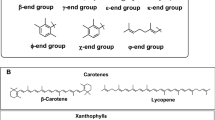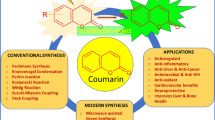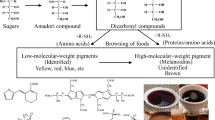Summary
1. FromScenedesmus acutus, Chlorella pyrenoidosa, Chlamydomonas reinhardii, Cladophora fracta andCladophora glomerata a trihydroxi-xanthophyll has been isolated. 2. With acidic methanol a diether, from this a monoacetate was obtained. Acetylation of the free pigment yielded a triacetate, the silylation of which was unsuccessful. 3. Oxidation of the triacetate with monoperphthalic acid gave a monoepoxide, which became furanoid after treatment with acidic ethanol. This was the same with the red epoxidic aldehyde, obtained by p-chloroanil oxidation. 4. NMR, mass and infrared spectra and chemical reactions were identical with those reported for loroxanthin.
Zusammenfassung
1. Aus den GrünalgenScenedesmus acutus, Chlorella pyrenoidosa, Chlamydomonas reinhardii, Cladophora fracta undC. glomerata konnte ein Trihydroxyxanthophyll isoliert werden. 2. Mit saurem Methanol konnte ein Diäther und von diesem noch ein Monoacetat erhalten werden. Das freie Pigment lieferte ein Triacetat, das nicht silanierbar war. 3. Oxydation des Triacetats mit Monoperphthalsäure brachte ein Monoepoxid, das unter Säureeinfluß furanoid wurde. Das galt auch für den rotgefärbten Aldehyd, der aus dem Epoxi-xanthophyll mittels p-Chloranil zugänglich war. Der Aldehyd lieferte nur noch ein Diacetat. 4. Die Daten, die aus Kernresonanz, Massen- und Infrarot-Spektren und den chemischen Reaktionen gewonnen wurden, ließen eine völlige Übereinstimmung mit Loroxanthin erkennen.
Similar content being viewed by others
Literatur
Aitzetmüller, K., Strain, H., Scec, W., Grandolfo, M., Katz, J.: Loroxanthin, a unique xanthophyll fromScenedesmus obliquus andChlorella vulgaris. Phytochem.8, 1761–1770 (1969)
Böhme, H.: Darstellung von Monoperphthalsäure mittels oxidation von Phthalsäure durch H2O2. Org. Synth.3, 619–625 (1955)
Bonnett, R., Mallams, A., Spark, A., Tee, J., Weedon, B., McCormick, A.: Carotenoids and related compounds. Part 20. Structure and reactions of fucoxanthin. J. chem. Soc. (C) (Lond.)1969, 429–454
Budzikiewicz, H., Brzezinka, H., Johannes, B.: Zur Photosynthese grüner Pflanzen. 2. Mitt.: Massenspektroskopische Untersuchungen an Carotinoiden. Mh. Chem.101, 579–609 (1970)
Curl, A., Bailey, G.: Polyoxigen carotenoids inValencia oranges. J. Agr. Food Chem.2, 685–690 (1954)
Curl, A., Bailey, G.: The state of combination of the carotenoids ofValencia orange juice. Food Res.20, 371–376 (1955)
Edmunds, F., Johnstone, R.: The constituents of cigarette smoke. Part 19. The pyrolysis of polyenes, and the formation of aromatic hydrocarbons. J. Chem. Soc. (C) (Lond.)1965, 2892–2897
Egger, K., Dabbagh, A.: Die Identität von Trollixanthin und Neoxanthin. Tetrahedron Letters17, 1433–1434 (1970)
Enzell, C., Jensen, S.: Mass spectrometric studies of carotenoids. 5. Steric effects in in-chain elimination reactions. Acta chem. scand.25, 271–276 (1971)
Hager, A., Stransky, H.: Das Carotinoidmuster und die Verbreitung des lichtinduzierten Xanthophyllcyclus in verschiedenen Algenklassen. III. Grünalgen. Arch. Mikrobiol.72, 68–83 (1970)
Herring, P.: The carotenoid pigments ofDaphinia magna. I. The pigments of the animals fedChlorella pyrenoidosa. Comp. Biochem. Physiol.24, 187–192 (1968)
Karrer, P., Helfenstein, A., Widmer, R., Itallie, Th.: Über Bixin. Helv. chim. Acta12, 741–752 (1929)
Kjösen, H., Jensen, S., Enzell, C.: Mass spectrometric studies of carotenoids. 4. Inchain elimination reactions. Acta. chem. scand.25, 85–93 (1971)
Kleinig, H., Nitsche, H., Egger, K.: The structure of siphonaxanthin. Tetrahedron Letters59, 5139–5142 (1969)
Krinsky, N.: A relationship between partition coefficients of carotenoids and their functional groups. Analyt. Biochem.6, 293–302 (1963)
Krinsky, N., Gordon, A., Stern, A.: The appearance of neoxanthin during the regreening of dark-grownEuglena. Plant Physiol.39, 441–445 (1964)
Krinsky, N., Levine, R.: Carotenoids of wild type and mutant strains of the green alga,Chlamydomonas reinhardii. Plant Physiol.39, 680–687 (1964)
Nitsche, H.: Die Struktur vonVaucheria-Heteroxanthin. Tetrahedron Letters38, 3345–3348 (1970)
Nitsche, H.: Mimulaxanthin—a new allenic xanthophyll from the petals ofMimulus guttatus. Phytochem.11, 401–404 (1972)
Nitsche, H.: Heteroxanthin inEuglena gracilis. Arch. Mikrobiol.90, 151–155 (1973a)
Nitsche, H.: The structure of vaucheriaxanthin. Z. Naturforsch. (in Vorbereitung, 1973b)
Nitsche, H., Egger, K.: Cis isomere Xanthophylle in Pflanzen. Phytochem.8, 1577–1582 (1969)
Nitsche, H., Egger, K., Dabbagh, A.: Deepoxineoxanthin, das Hauptcarotinoid in Blüten vonMimulus guttatus. Tetrahedron Letters35, 2999–3002 (1969)
Nitsche, H., Pleugel, C.: Neoxanthin from the petals ofHelianthus, Taraxacum andImpatiens. Phytochem.11, 3383–3385 (1972)
Ricketts, T.: The structures of siphonein und siphonaxanthin fromCodium fragile. Phytochem.10, 155–160 (1971)
Ruppel, H.: Untersuchungen über die Zusammensetzung vonChlorella bei Synchronisation im Licht. Flora (Jena)152, 113–122 (1962)
Schimmer, B., Krinsky, N.: The structure of neoxanthin and the trollein-like carotenoid fromEuglena gracilis. Biochemistry5, 1814–1820 (1966)
Schwieter, U., Englert, G., Rigassi, N., Vetter, W.: Physical organic methods in carotenoid research. Pure appl. Chem.20, 365–420 (1969)
Senger, H.: Untersuchungen zur Synchronisation vonChlorella-Kulturen. Arch. Mikrobiol.40, 47–72 (1961)
Strain, H., Aitzetmüller, K., Svec, W., Katz, J.: Structure of heteroxanthin, a unique xanthophyll from the Xanthophyceae (Heterocontae). Chem. Commun.1970, 876–877
Strain, H., Svec, W., Aitzetmüller, K., Katz, J.: A comparison of the formulas proposed for heteroxanthin. Tetrahedron Letters10, 733–736 (1971)
Sueoka, N.: Mitotic replication of DNA inChlamydomonas reinhardii. Proc. nat. Acad. Sci. (Wash.)46, 83–91 (1960)
Walton, T., Britton, G., Goodwin, T., Diner, B., Moshier, S.: The structure of siphonaxanthin. Phytochem.9, 2545–2552 (1970)
Weber, A.: Über die Chloroplastenfarbstoffe einiger Conjugaten. Flora (Jena)160, 457–473 (1969)
Weedon, B.: Spectroscopic methods for elucidating the structures of carotenoids. Fortschr. Chem. Org. Naturst.27, 81–130 (1969)
Yamamoto, H., Yokoyama, H., Böttger, H.: Carotenoids ofChlorella pyrenoidosa. Pyrenoxanthin, a new carotenol. J. Org. Chem.34, 4207–4208 (1969)
Zechmeister, L., Tuzson, P.: Isomerization of carotenoids. Biochem. J.32, 105–108 (1938)
Author information
Authors and Affiliations
Rights and permissions
About this article
Cite this article
Nitsche, H. Die Identität von Loroxanthin mit Pyrenoxanthin, Trollein und Trihydroxy-α-Carotin. Arch. Microbiol. 95, 79–90 (1974). https://doi.org/10.1007/BF02451750
Received:
Issue Date:
DOI: https://doi.org/10.1007/BF02451750




